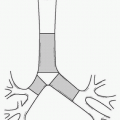Colorectal Stent Placement
Jin Hyoung Kim
Ho-Young Song
Ji Hoon Shin
In 1992, Spinelli et al. (1) first described metallic stent placement within the colon for treatment of malignant large bowel obstruction. Since then, metallic stents have been increasingly used for safe nonsurgical palliation for unresectable malignant colorectal obstructions and as a bridge to surgery to allow stabilization of the patient’s condition (2,3,4,5,6,7,8,9,10,11,12,13,14,15,16). Because surgical decompression has been associated with high morbidity and mortality, minimally invasive stent placement is preferred to open surgery (2,11,12,13). Colorectal stent placement is performed via the transanal route under a fluoroscopic guidance alone or in combination with endoscopy. Placement under conscious sedation is generally well tolerated by patients. The procedure allows immediate large bowel decompression with rapid resolution of patients’ symptoms and restoration of normal intestinal transit (11,12).
1. Temporary colonic decompression to allow stabilization of the patient’s condition before curative surgery for malignant or benign (rarely) colorectal obstructions
2. Palliative treatment in patients with inoperable malignant colorectal obstructions
3. Covered stent placement for colonic fistulae
1. Clinical or imaging evidence of perforation or peritonitis
2. Uncorrectable coagulopathy
3. Multiple obstructive lesions of the small bowel
4. Extension of rectal cancer to the anal sphincter
5. Location of obstruction is far too proximal within the colon (antegrade approach via cecostomy has been described).
6. Obstruction is too long.
Preprocedure Preparation
1. Obtain informed consent.
2. Barium studies and/or endoscopy to evaluate the site, severity, and length of the stricture and perforation or proximal synchronous stricture
3. Prophylactic antibiotics are not routinely recommended.
4. Perform cleansing enema to clear the distal colon.






